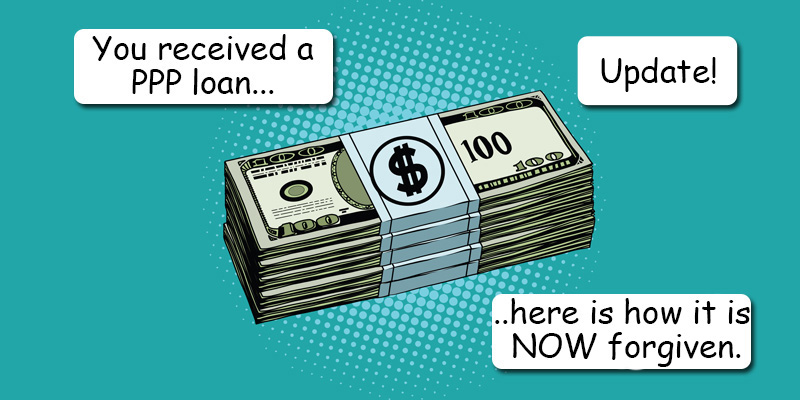We have not seen much change in relation to PPP loan forgivness, although there are a few notable updates.
Payroll costs includes the wages up to $100,000 of annualized pay per employee. For those using the eight-week covered period, that is a maximum of $15,385 per individual, and for those using the 24-week covered period, that will be a maximum of $46,154 per individual. A company does not have to wait the full 24-weeks to file for forgiveness if they meet the spending requirements sooner. Let’s say you spend 100% of the loan amount on payroll costs after just 10 weeks. In this case, the maximum amount per individual would be 10/52 of $100,000, or $19,230. A question may arise as to then why file after 10 weeks and not wait out the full 24. The reason is that the longer your covered period covers, the longer you need to maintain your FTE count compared to pre-COVID-19 levels.
There is a different limitation for owners, general partners, or self-employed individuals. That amount is capped at the lesser of;
- $15,385 (the eight-week equivalent of $100,000), or
- the eight-week equivalent (15.385%) of their compensation for 2019, or
- $20,833, if using the 24-week covered period.
This limit for owners is across all business the owner may be seeking PPP forgiveness on. This may be a problem for an owner of multiple businesses where each one received a PPP loan as well as the business owner who did not take any, or a very low, salary in 2019.
For those who are ready to file for forgiveness, you will find that it is not available just yet. The SBA is pushing to have their forgiveness portal open on August 10th. Keep in mind that there is no rush to file. Forgiveness can be applied for up to 10 months after the end of your covered period.
There is legislation working its way through DC that may make the forgiveness process much easier for smaller loans, so there is another reason not to rush.
There is no limit on the amount of the loan to file for forgiveness under the new EZ application form, as long as you meet one of three qualifications. The three qualifications are;
- The Borrower is a self-employed individual, independent contractor, or sole proprietor who had no employees at the time of the PPP loan application and did not include any employee salaries in the computation of average monthly payroll in the Borrower Application Form.
- The Borrower did not reduce annual salary or hourly wages of any employee by more than 25 percent during the Covered Period or the Alternative Payroll Covered Period (as defined below) compared to the period between January 1, 2020 and March 31, 2020 (for purposes of this statement, “employees” means only those employees that did not receive, during any single period during 2019, wages or salary at an annualized rate of pay in an amount more than $100,000); AND one either of the two options below;
- The Borrower did not reduce the number of employees or the average paid hours of employees between January 1, 2020 and the end of the Covered Period. (Ignore reductions that arose from an inability to rehire individuals who were employees on February 15, 2020 if the Borrower was unable to hire similarly qualified employees for unfilled positions on or before December 31, 2020. Also ignore reductions in an employee’s hours that the Borrower offered to restore and the employee refused.
- The Borrower was unable to operate during the Covered Period at the same level of business activity as before February 15, 2020, due to compliance with requirements established or guidance issued between March 1, 2020 and December 31, 2020 by the Secretary of Health and Human Services, the Director of the Centers for Disease Control and Prevention, or the Occupational Safety and Health Administration, related to the maintenance of standards of sanitation, social distancing, or any other work or customer safety requirement related to COVID-19.
Full details can be found in the EZ Form Instructions.
In any case, it appears that as time goes on, we can count on the rules changing. While many changes may be an advantage in receiving 100% forgiveness or making the process easier, we have found some, such as the owner limitation, to cause grief. As I type this week’s blog, D.C. is in the midst of additional benefits and changes as part that may take the form of the HEALS, CARES, or HEROES Act, so keep an eye out for new developments later next week.
While I make every attempt to ensure the accuracy and reliability of the information provided in this article, the information is provided “as-is” without warranty of any kind. PayMaster, Inc and Romeo Chicco do not accept any responsibility or liability for the accuracy, content, completeness, legality, or reliability of the information contained. Consult with your CPA, Attorney, and/or HR Professional as the SBA and Congress continues to produce new and revised guidance on this program.

